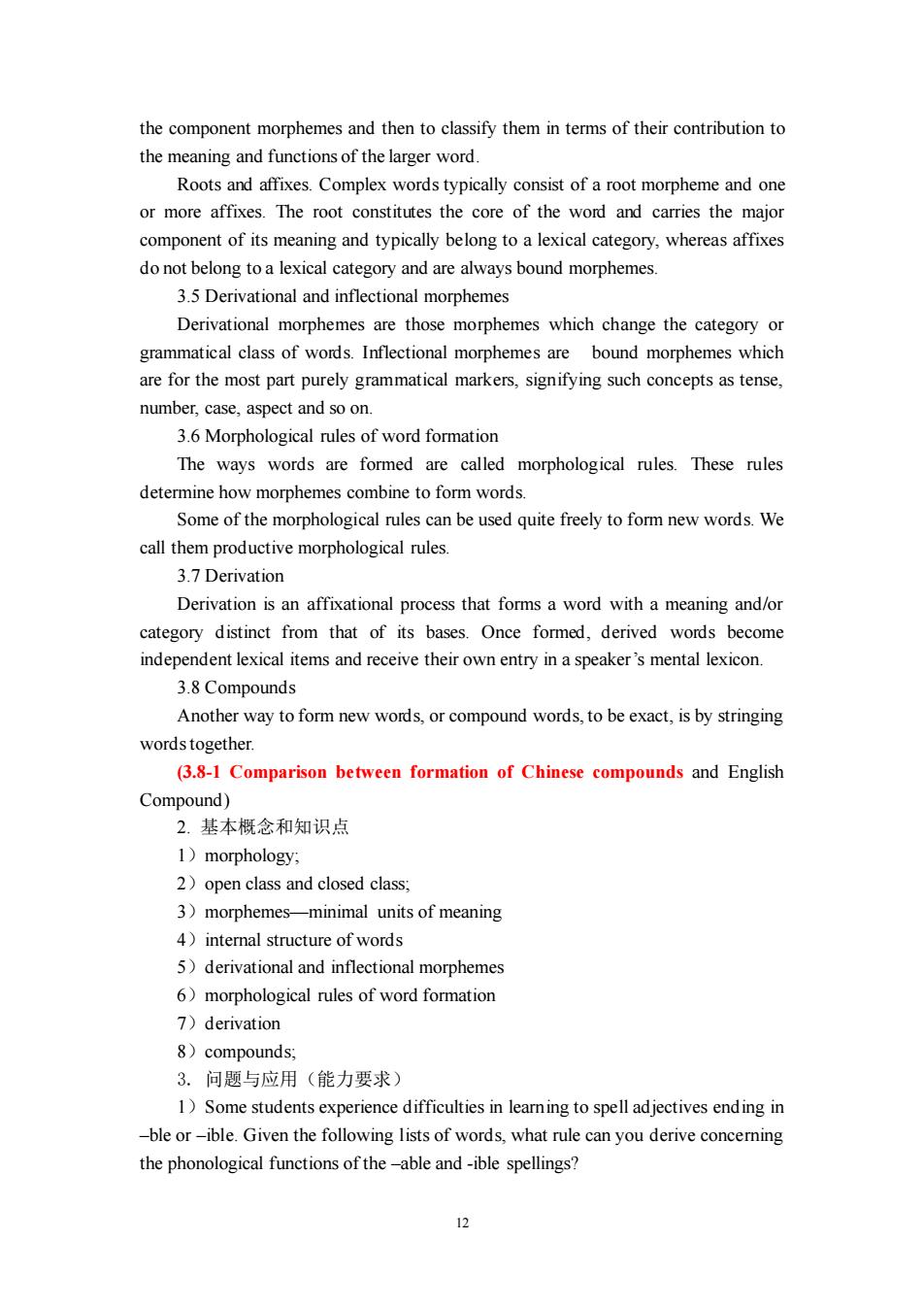正在加载图片...

the component morphemes and then to classify them in terms of their contribution to the meaning and functions of the larger word. Roots and affixes.Complex words typically consist of a root morpheme and one or more affixes.The root constitutes the core of the word and carries the major component of its meaning and typically belong to a lexical category,whereas affixes do not belong to a lexical category and are always bound morphemes. 3.5 Derivational and inflectional morphemes Derivational morphemes are those morphemes which change the category or grammatical class of words.Inflectional morphemes are bound morphemes which are for the most part purely grammatical markers.signifving such concepts as tense. number,case,aspect and so on. 3.6 Morphological rules of word formation The ways words are formed are called morphological rules.These rules determine how morphemes combine to form words. Some of the morphological rules can be used quite freely to form new words.We call them productive morphological rules. 3.7 Derivation Derivation is an affixational process that forms a word with a meaning and/or category distinct from that of its bases.Once formed,derived words become independent lexical items and receive their own entry in a speaker's mental lexicon. 3.8 Compounds Another way to form new words,or compound words,to be exact,is by stringing words together (3.8-1 Comparison between formation of Chinese compounds and English Compound) 2.基本概念和知识点 1)morphology; 2)open class and closed class. 3)morphemes-minimal units of meaning 4)intemal structure of words 5)derivational and inflectional morphemes 6)morphological rules of word formation 7)derivation 8)compounds: 3.问题与应用(能力要求) 1)Some students experience difficulties in learning to spell adjectives ending in -ble or-ible.Given the following lists of words,what rule can you derive conceming the phonological functions of the-able and -ible spellings? 12 the component morphemes and then to classify them in terms of their contribution to the meaning and functions of the larger word. Roots and affixes. Complex words typically consist of a root morpheme and one or more affixes. The root constitutes the core of the word and carries the major component of its meaning and typically belong to a lexical category, whereas affixes do not belong to a lexical category and are always bound morphemes. 3.5 Derivational and inflectional morphemes Derivational morphemes are those morphemes which change the category or grammatical class of words. Inflectional morphemes are bound morphemes which are for the most part purely grammatical markers, signifying such concepts as tense, number, case, aspect and so on. 3.6 Morphological rules of word formation The ways words are formed are called morphological rules. These rules determine how morphemes combine to form words. Some of the morphological rules can be used quite freely to form new words. We call them productive morphological rules. 3.7 Derivation Derivation is an affixational process that forms a word with a meaning and/or category distinct from that of its bases. Once formed, derived words become independent lexical items and receive their own entry in a speaker’s mental lexicon. 3.8 Compounds Another way to form new words, or compound words, to be exact, is by stringing words together. (3.8-1 Comparison between formation of Chinese compounds and English Compound) 2. 基本概念和知识点 1)morphology; 2)open class and closed class; 3)morphemes—minimal units of meaning 4)internal structure of words 5)derivational and inflectional morphemes 6)morphological rules of word formation 7)derivation 8)compounds; 3. 问题与应用(能力要求) 1)Some students experience difficulties in learning to spell adjectives ending in –ble or –ible. Given the following lists of words, what rule can you derive concerning the phonological functions of the –able and -ible spellings?